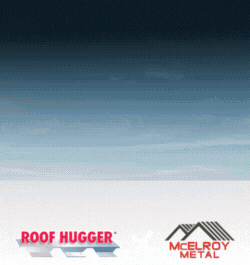Get to know the GT-1 and the XL gutter - PODCAST TRANSCRIPT
December 26, 2023 at 12:00 p.m.Editor's note: The following is the transcript of a live interview with Eric Younkin from MTL Holdings. You can read the interview below or watch the webinar.
Heidi J. Ellsworth: Hello, and welcome to another lunch-and-learn from Roofer's Coffee Shop. My name is Heidi Ellsworth. Today, we're here to talk about something that's not always top of mind, but should be, and that's gutters. We are really looking at the age when gutters are so important and commercially more important than ever, and they need to be big. We have a lot of rain coming down out there, so we've asked our friends from MTL Holdings to come join us for this lunch-and-learn to be able to talk about their newest extra-large gutter and the importance of GT-1 Standard.
Eric Younkin, thank you so much for joining us today on this lunch-and-learn.
Eric Younkin: Thank you for having me. I'm excited to talk about gutters. There's been a lot of buzz let's just say around the topic because of the recent adoption of the GT-1 Standard into IBC, International Building Code.
Heidi J. Ellsworth: There's a lot that people need to know. This is going to be incredibly educational, as all of our lunch-and-Learns are, but it's really going to give you what you need to bring the right products to the market. Before we get started, remember, you have your discussion sheet. Please print it out and use it. Make notes as you go along to be able to talk with your team. Have that discussion after this lunch-and-learn, and please take pictures while you're watching the lunch-and-learn. Send them in, and you may get a free lunch from Roofers Coffee Shop.
Today, on the topic of getting to know GT-1 XL Gutters, the three learning objectives are, one, the importance of GT-1 Standard, two, how the XL Gutter meets GT-1 requirements and, three, saving time and materials on the job site with XL Gutters. Before we start on those learning objectives, I am going to have... Eric, if you could introduce yourself, tell us a little bit about you and MTL Holdings.
Eric Younkin: Sure. Eric Younkin. I'm the vice president of products and engineered services for MTL. I've been in the roofing industry, now, this is going into my 24th year, so I've had the opportunity to play in the field of the roof on the membrane side. I joined the MTL family going on three years ago now, so now I'm on the edge.
MTL is actually a holding or a parent company for three specific brands. I'll go in the opposite order as what they're listed up on the screen here, but Metal-Era, the number one manufacturer of specified engineered edge metal system in the marketplace, and then, recently, added to that in 2021 to the family was Hickman Edge Systems. Hickman Edge Systems is a sister company of ours located in Asheville, North Carolina. They are a great manufacturer of engineered metal as well. We have multiple locations and multiple brands for engineered edge systems, whether that be fascia, coping or, in today's topic, gutters, and then we also have added to our family Citadel Architectural Products. They are a manufacturer of ACM/MCM panels, whether that be sheets or fabricated systems or what we call sticks and sheets, which can be field-fabricated assemblies for ACM/MCM panels, as well as glass and glazing infill panels.
Heidi J. Ellsworth: You've brought amazing companies together, and I've been so lucky to work with Metal-Era and Hickman and now, Citadel. Very exciting, so, eric, let's get onto these questions. I've talked to you so many times about gutters and I'm still excited to hear about more. Let's start with our first learning objective, which is the importance of GT-1 Standard. Eric, talk to us about, first, what is GT-1?
Eric Younkin: GT-1 is a test standard specific to gutters. I like to refer it as the gutter version for ES-1, which ES-1 is what is written in code for fascia, drip edge, gravel stops and copings. This is the next version which is related to gutters. What the industry's noticed over the years is, when gutters fail, meaning, they tear off of a building because of wind or something, it's the damage that it causes to the roof and the waterproofing. The intent of this is really to help prevent damage to the roof membrane if there is a gutter failure.
As I said, GT-1 is a standard that was put together by ANSI/SPRI and it was most recently adopted into IBC, but the test standard itself is composed of three separate tests. There's a vertical test where you're pushing upwards, which is going to be more indicative of what I'd say wind. I think that's more of a wind-type test. The other is an outward pressure, so pulling on the gutter out away from the building, and then the third is a downward, more of what I would call a load, like a snow, ice or wind load, or snow, ice or water load I should say. That's in essence what the test is. It's three specific tests, upward, outward and downward.
Heidi J. Ellsworth: Really, I mean, with it going into code overall, this is really going to start affecting contractors everywhere. How is this going to affect the roofing contractors and what should they be thinking about?
Eric Younkin: Yeah. First, as you mentioned getting into code, a little funny story, we were in a meeting just at the very end of August and, at the time, I think there was 14 states that have adopted code, and so, last week, we were with our internal folks and I said, "Yeah, there's 14 states," and then someone raises their hand and like, "No. It's 21 now." The adoption into state code is happening relatively fast and, in the near future, all 50 states are going to adopt the new 2021 IBC version for code. It is coming into code, so, anytime you're installing a roof, you want to make sure that you're code compliant. If you're not, installing a roof that's not code compliant, it depends on the local area what the implications can be, but, really, if you're doing the best thing for your customers and meeting code, you're going to have to install a gutter that is GT-1 tested and approved, or not approved, but GT-1 tested.
Heidi J. Ellsworth: Right. I mean, contractors want to be within code. That's the last thing you wanted to have, something happened and not have really done the whole thing. Why was it so important to establish that high industry standards for gutters, and how does it relate to the roofing membrane?
Eric Younkin: Yeah. That's exactly what it was, the whole purpose. The intent of this is to protect the building. The gutters are designed to take water off of the roof and move it away, and so we want to make sure that we're always doing that properly. That's done through proper gutter sizing, downspout placement, downspout sizing, but what we don't want to have happen is, if there is a failure, if that gutter blows off because of wind and it comes up on the roof and peels off the roof membrane, now we have water infiltrating the building, we've compromised the internal contents of the building. It's really important that the gutter be attached and stay attached to prevent damage to the roofing membrane.
Heidi J. Ellsworth: Yeah. Yeah, it's so important. Well, with that, let's move on because this is leading right into it. Let's move into our second learning objective, which is how the XL Gutter meets GT-1 requirements. Okay. Eric, maybe start out with just telling everybody. Let's talk a little bit about the XL Gutter overall first.
Eric Younkin: A couple of things, what we've seen from the manufacturing standpoint is an increased demand for larger gutters. In the past, someone will say, "Oh, I have a large gutter. It's six inches," and then all of a sudden it was like, "Well, maybe an eight-inch gutter," but now what we've seen, because of the size of these construction jobs we have going on, big bucks, we're seeing the need for some very large gutters. We're talking up to 14 inches. They're going to have a lot of weight that they're going to have to manage, a lot of water, because these roofs are so big. If you go through and you do a calculation of what size of gutter you need, as these buildings get bigger and bigger and bigger, there's just an increasing demand for what we call extra-large gutters. Our definition of extra-large is basically anything over eight inches. That's our classification of extra-large.
Heidi J. Ellsworth: You've just come out with this brand new product, XL Gutters. I mean, it's just launched this fall or, actually, late summer. Just before we get into the requirements with GT-1, just tell us a little bit about that because it is phenomenal, the engineering behind your XL Gutter.
Eric Younkin: Yeah. We've always made larger gutters and, like most folks, we would always use external brackets. The external brackets can be tedious for installation, depending upon if the wall is perfectly straight, also how the gutter is going to sit into it, so that becomes a trick, and we've got that feedback from our contractors. Also, in my opinion, the aesthetics of having straps every so often on the gutter, some people might say, "Oh, I know that it's attached now because I see the straps," but, aesthetically, I don't know personally if I like that.
We've always done it that way. That was our solution to these larger gutters, but as GT-1 was being adopted in the code, we quickly realized that those external straps aren't going to provide the testing information, the testing data we need because we're talking about three directional testing, downward, outward and upward. Those brackets, that gutter is easily going to peel up. The intent of our design is really to make sure that this gutter is going to remain attached at any wind speed or any high wind speed and meet the testing of GT-1.
The test really challenged our engineering team to go in and say, "How do we design a gutter that can meet the testing requirements of GT-1?" We have what we call a lower mounting hanger, and we use what we call, internally, it's called the route arm, but it's a way that we can set this lower mounting hanger exactly where it needs to be on the building, utilizing that from the top of the nailer. We have a pre-measured device, our route arm, that hooks into this lower mounting hanger and sets it in the precise location on the wall. That way, once that's attached, we don't have to chalk a line, we don't have to be hanging over the side of the roof. It's very easy to do. Once that's attached, we now have a straight line for where our gutters are going to go.
It's taking out the guessing game. It's taking out additional labor. It's increasing safety by minimizing the amount of time you have to be over the edge of the roof, so a really cool, little thing, a trick that they built into the product. As I go through talking about our XL Gutter, all of this is patent pending because of the initial design. Our engineering team just did a phenomenal job.
Once you install that lower mounting hanger, we have a cleat that's built into the gutter itself with a specialized non-piercing solution so there's no holes in the gutter at all and you're actually able to slide the gutter into that lower mounting hanger and, once it's sent in, you could just tack in a couple nails to hold the gutter in place and then you're fine. It's just going to hold the gutter temporarily while you go through your process of finishing the installation. The next piece that would go-
Heidi J. Ellsworth: It's-
Eric Younkin: I'm sorry. Go ahead.
Heidi J. Ellsworth: No. I was going to say it's through that design element that you did that really makes it meet all the requirements for GT-1. Right?
Eric Younkin: Yes. As we go through it, we have what I call a three-directional or a three-piece internal bracket. This internal bracket is put into the gutter while it's on the top in the field of the roof. That three-piece bracket, it's important that it's three pieces. This is the engineering piece behind it because it has stopping points for each of the tests, whether it go upward, outward or downward, there's built-in stopping points or a little wall that it has to hit, so it helps with that testing. If you imagine upward pressure wind pulling up on a gutter, the key to performance is going to be having that gutter at its lowest point remain in contact with the wall somehow. That lower mounting hanger and this cleat are intricate to how that happens. It's free floating. It's allowed to sit in there, but, once engaged, it's going to ensure that that gutter remained tight against that building.
We had the opportunity to get on a couple of jobs with some contractors. After they set the gutter into this lower mounting hanger and they just tacked the gutter in place to hold it because they may want to put a drip edge into the gutter behind the real brackets that are going to hold it in place or whatever waterproofing they're going to do, after that's done, they go and they will actually attach the three-piece hangers, internal hangers, into the wood nailer. Once that's done, now you have a gutter that is just exceptionally strong. In the words of the contractor, as soon as they put in a couple of those hangers, the comment was strong like bull. It's really a combination of the pieces that come together to account for each of the specific test requirements of GT-1.
Heidi J. Ellsworth: It's that internal bracket that really sets it apart from other XL, whatever that means, XL gutters out there on the market.
Eric Younkin: Yeah. It's all internal, so you don't have to worry about the external straps aesthetically and how the gutter is going to sit in each of those. Typically, you have to chalk a line and put those external straps on before you set the gutter in place. Now, what happens if the gutter doesn't set right? Do you have to reset the external brackets? Being internal, these are all the same size, our lower mounting hanger has established the precise point at where the gutter should lie. It lines up perfectly on top of the wood nailer and, once we attach it, it's done, all internal.
That lower mounting hanger, believe it or not, to me, it looks like maybe a little crown molding or a quarter round, so, when you look up, it looks uniform, you don't see these gaps between the gutter and the building. You don't see the external straps, so, aesthetically from the ground, it gives it a nice appearance. The beautiful thing is now that we have a larger gutter, we can now start to hold more water, which means we can maybe have longer runs for our downspouts. Maybe we want to span our downspouts further out because of the building design. Maybe we want it for architectural aesthetics. The downspout placement now becomes more flexible because we have the ability to make a larger gutter.
Heidi J. Ellsworth: Architects are going to like that.
Eric Younkin: Yes.
Heidi J. Ellsworth: Yes, and contractors and building owners. I mean, when you think about it, that's also a cost savings.
Eric Younkin: Yeah. It's funny you say that because, when you think about gutters, with everything that's going on with inflation today, nothing is cheap anymore. People look at gut gutters, and they do cost money, but, ironically, the downspouts are, if not more, just as costly as the gutter itself. If you could start to minimize what we call drops, the number of drops from your gutter, if you can minimize that, you're not only saving in material, but in labor of installation. You could provide a cheaper or I would say more cost-effective solution to your customer by maybe going to a larger gutter with fewer downspouts.
Heidi J. Ellsworth: Right. Right. That makes so much sense. Yeah. Okay, and that is leading us right into our third learning objective. When you talk about number three, our third learning objective is saving time and materials on the job site with XL Gutters. Eric, we were already on course for this learning objective. We know it makes sense. Not having as many drops, you're going to have cost savings that way. Let's talk a little bit about labor also. We know, we showed earlier and talked about earlier that installation and how it's so different from traditional ways of installing getters. How is it saving labor costs for contractors by using this new XL Gutter?
Eric Younkin: Very interesting, when we first launched this, of course, we went out with our customers to get their feedback, and we were fortunate enough to do a job in South Florida. We started off with the crew. Let's just throw out some round numbers. They typically hang a hundred feet of gutter. Again, I'm not being exact, but just throwing this out as a reference. We started. Of course, we made sure everything was there. We talked them through the process. We explained the product. We spent two hours of their day already just explaining what's going to go on. We want to, of course, get some video and stuff like that, go over safety, do all that stuff with our team. We spent about two hours of their day before they got started, and then, as they started to learn, the first piece went in relatively slow, then they started to use their expertise and how they can tweak their processes. They finished the day early because of rain. If they would typically do a hundred feet, they ended up stalling 120 feet.
The contractor's initial response was, "I think I can save up to 60% of my labor time. I could put down that much more with this particular installation." It was a big roof, of course, so they had multiple days of gutter installation and kept going back and getting feedback. He typically had a crew of, I think it was five or maybe it was six people, and someone was taking a vacation. They allocated some other guys to a different job, so they ended up with three people, three installers doing more linear footage in a in a day than they typically would with six.
Heidi J. Ellsworth: Wow.
Eric Younkin: When you talk about it, they increased their production by more than 50%, less people, more linear footage. That right there was an ultimate win. They talked about not having to do the external brackets, not only from the labor of installing them, but it was also the time it takes when you have to create these external brackets, which is a heavy metal, which is expensive and then you have to send that out to get painted to match the color of your gutter, so now the time getting painted and the additional cost of painting these external brackets, we're able to do all of that for a cheaper price by having it ready to ship. We can manufacture immediately with standard colors. There's no external brackets, so it saves all of that time, and we're doing it for less than we would with external brackets with greater-than-50% productivity on the roof. I don't see where there's not a win in this for everybody.
Heidi J. Ellsworth: I know. That's amazing. To hear that coming back from the contractors on how much money it's saving them, labor, being able to get onto the next job faster, but let's talk about the really big thing with this, which is number one in all contractors mind, and that's safety. I mean, with your new system, it is so much safer. Talk about that.
Eric Younkin: Yeah. Like I said, that roofing contractor went down to three people. They had one on a lift from the ground and then two on the roof. Since once you install that lower mounting bracket and you're not hanging over doing an external bracket all the time because everything is going to be internal, that process of putting that lower mounting hanger up is fast. It's very fast. Now we're just minimizing the amount of time hanging over the roof because, once that bracket is up and you slide the gutter into it and you tack it, you don't have to go over the side anymore. You're done.
Safety is a big concern, and that was a big factor. I'll be honest, when I first saw the idea, the concept behind what we were doing, I wasn't sure if I liked it or not until they pulled out what we call a rack arm and they were like, "We don't have to hang over the edge. Look, we set it, screw it and we're done," and I'm like, "Oh, now we're providing additional support, additional safety and labor savings to the contractor." That's when my light bulb went off and I was like, "Wow, you guys are on to something here."
Again, what the engineering team did, when we come up with a new product, we always talk what's important, performance, safety. Price is always a consideration. How do we meet all of these criteria and what's the most important, and they really did a bang up job hitting all of those categories. It's a really cool product. Again, this is what we take from eight inches up to 14 inches. We go in one-inch increments as standard sizes that's pretty easy to do, 8, 9, 10, 12, all the way up, and then, anything below that, we have what we call our wind-resistant gutter, which is an internal bracket of two, nothing external, and that is also GT-1 tested, warranted, just as our XL Gutter is, up to 20 years, 120 mile an hour winds. That's our warranty that's provided with it.
Heidi J. Ellsworth: I was just going to ask about warranty. I was going to say, and so how is this all warranted? Talk about that a little bit.
Eric Younkin: Yeah. It's warranted by us through either Metal-Era or through Hickman so you could get a manufacturer's warranty. What we're seeing a larger uptake is and questions is inclusion into the membrane warranty. We're starting to see more and more of that. Warranties are starting to become single-source warranties, the old "one throat to choke" saying. Yeah, this definitely becomes part of the warranted system. We're happy to extend that warranty out to them individually or we can work as part of a complete roof system.
Heidi J. Ellsworth: Yeah. I just love it, so I want to summarize this because I think this third learning objective of saving time and materials on the job site with XL Gutters, when you look at everything that you're talking about from the labor savings, the amount of installers that you need to install this, safety, fewer downspouts, and it's all warranted either through the membrane or through you. It goes back to what you were saying earlier. It's such a win-win-win. Why wouldn't you look at these XL Gutters? I want to just I guess recap a little bit because, when you think about what's going on with severe weather right now, the amount of snow, the amount of wind, the amount of rain, really meeting those GT-1 Standards and then being able to offer all of these savings for the contractor and for the building owner, it just makes sense.
Eric Younkin: It really does. We're excited about it. Labor is probably the number one resource that we're lacking mostly in our industry. Being able to address that with a GT-1 tested, if you want to say, a building code approved, something that meets code while providing that to the roofer, like you said, is a win-win
Heidi J. Ellsworth: With half the crew.
Eric Younkin: Yes. You can reallocate those resources to go get more projects, install more roof, make more money.
Heidi J. Ellsworth: Right. Install more XL Gutters. I love it. Well, Eric, thank you so much. This has been incredibly helpful, educational. I do want to ask if people are interested after watching this lunch-and-learn in actually starting to look at installing XL Gutters, how would they get a hold of you and what is the process?
Eric Younkin: You could go to our website metalera.com. You could click on that, and there's a contact us. That's easy to do. We have local representatives. You could find a rep through either of our Metal-Era or our Hickman website. You can find a rep locally, or you could simply find us on the web and give us a holler, whatever is easiest, whatever your preference is. If you want, I would be more than happy to share my contact information as well. Feel free to reach out to me, yeah, whatever is best for the roofer or whoever's interested in it. Yeah, we love to entertain those questions.
I would also say, if anybody wants to understand if the IBC 2021 code has been adopted in their state, currently there's 20, and then there's a lot of municipalities that have adopted it specifically. The state of Texas currently has not adopted that code yet, but I believe Austin, Dallas, Fort Worth, the large municipalities in Texas have already adopted it. Until the state adopts it, it's still being adopted locally, you can simply go into Google and type "state adoption of IBC 2021 code" and you could get the updated list. Like I said, as of today, there's 20, with a lot of municipalities for states that don't have it, but that's something you may want to look at if you question, well, is that even relevant for me? Again, it will become relative for all 50 states in the near future.
Heidi J. Ellsworth: I was just going to say, if it's not now, it will be soon because we know how that all works. Well, thank you, Eric. Thank you so much, and thank you, everyone, for listening today and enjoying this lunch-and-learn. Please remember your discussion sheet and your three learning objectives, the importance of GT-1 Standard, how the XL Gutter meets GT-1 requirements and saving time and materials on the job site with XL Gutters. I hope you enjoyed this lunch-and-learn, Eric. Again, thank you so much for being with us today.
Eric Younkin: Thank you.
Heidi J. Ellsworth: Thank you, and thank you all for listening. We'll be seeing you next time on the next lunch-and- learn from Roofers Coffee Shop. Have a great day.























Comments
Leave a Reply
Have an account? Login to leave a comment!
Sign In